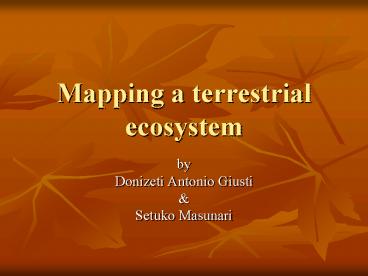Mapping a terrestrial ecosystem PowerPoint PPT Presentation
1 / 8
Title: Mapping a terrestrial ecosystem
1
Mapping a terrestrial ecosystem
- by
- Donizeti Antonio Giusti
- Setuko Masunari
2
Abstract
- A map of the distribution of the fauna, the flora
and their relationship with the abiotic
parameters was done in a forest ecosystem. An 10
m2 area was chosen and 1 m2 grid was done. Air
and soil temperature, soil moisture and air
moisture were noted. Animals were registered with
the aid of 10 pitfalls and manual collecting.
Trees were identified and the vegetation cover
noted at the collection site. The air temperature
ranged between 29.0 and 29.5OC, the soil one from
22.0 to 24.0OC. Parts of the soil were wet and
others dry. A total of 18 invertebrate and four
tree species were identified. The soil was
covered by litter, vine or bare in different
levels of thickness. In a general way, animals
were present in covered area. These data were not
enough for understanding the terrestrial
ecosystem, but they sufficient to map a small
area using GIS program.
3
Objectives
- Map a small terrestrial ecosystem using the GIS
program. - Identify animals and plants and do correlations
with abiotic parameters.
4
Questions to be answered
- How oscillate the air temperature, the soil
temperature, soil texture and moisture ? - What animal and plant species are in this
ecosystem ? - What is the relationship between communities and
abiotic parameters ?
5
Methods
- A 10m2 area was chosen and a 1m2 grid was done.
- The following abiotic parameters were measured
air and soil temperature, soil texture and
moisture. - Animals were collected with the aid of pitfall
traps. Also, the ground cover was searched to
register the soil animals. - Vegetation cover was searched.
- Tree species were identified.
- GIS and ArcView were used to map the distribution
of living beings.
6
Results
7
Conclusion
- GIS is a powerful tool for mapping and doing
correlation between biotic and abiotic
parameters.
8
Acknowledgements
- Dr. Stubbs for this unique opportunity.
- Kris, Dee Dee and Jessica for their infinite
patience. - Speakers for the interesting conferences.
- Andrews, Ms. Williams and Kimberley for helping
us in the day-by-day complications. - The NC State University and other sponsors of
this program.

